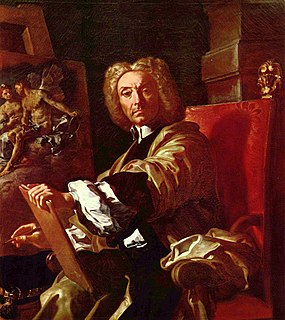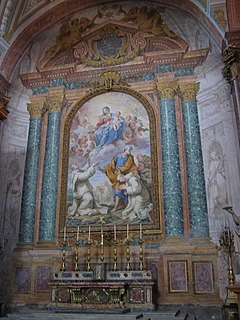This article relies largely or entirely on a single source .(August 2015) |


Paolo Porpora (1617–1673) was an Italian painter of the late-Baroque, who was active mainly in Naples and specialized in floral still lifes. He is documented as a pupil of Giacomo Recco, the father of Giuseppe Recco, and said to have worked under Aniello Falcone. He joined the Roman Accademia di San Luca from 1656 to 1658. He appears to have been influenced in Rome by Netherlandish still-life painters. Among his pupils were Giovan Battista Ruoppolo and the Neapolitan Onofrio Loth (died 1717). [1]

Italy, officially the Italian Republic, is a European country consisting of a peninsula delimited by the Italian Alps and surrounded by several islands. Located in the middle of the Mediterranean sea and traversed along its length by the Apennines, Italy has a largely temperate seasonal climate. The country covers an area of 301,340 km2 (116,350 sq mi) and shares open land borders with France, Slovenia, Austria, Switzerland and the enclaved microstates of Vatican City and San Marino. Italy has a territorial exclave in Switzerland (Campione) and a maritime exclave in the Tunisian sea (Lampedusa). With around 60 million inhabitants, Italy is the fourth-most populous member state of the European Union.

The Baroque is a highly ornate and often extravagant style of architecture, music, dance, painting, sculpture and other arts that flourished in Europe from the early 17th until the mid-18th century. It followed the Renaissance style and preceded the Rococo and Neoclassical styles. It was encouraged by the Catholic Church as a means to counter the simplicity and austerity of Protestant architecture, art and music, though Lutheran Baroque art developed in parts of Europe as well. The Baroque style used contrast, movement, exuberant detail, deep colour, grandeur and surprise to achieve a sense of awe. The style began at the start of the 17th century in Rome, then spread rapidly to France, northern Italy, Spain and Portugal, then to Austria and southern Germany. By the 1730s, it had evolved into an even more flamboyant style, called rocaille or Rococo, which appeared in France and central Europe until the mid to late 18th century.

Naples is a major city in southern Italy. It is the capital of the Campania region, and the third-largest municipality in Italy after Rome and Milan. The city is called Napoli in Italian, and Napule in Neapolitan. The name comes from Ancient Greek Νεάπολις, meaning "new city", via the Latin Neapolis.








